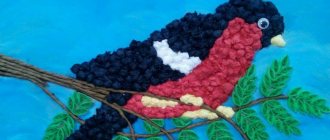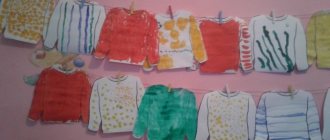Consistent formation of spatial orientation in preschool age
The formation of spatial orientation is several successive stages of a child’s acquisition of the necessary knowledge, skills and abilities.
- Self-orientation. The baby acquires knowledge about the location of parts of his own body.
- Orientation "from yourself". The child develops visual-motor coordination and distinguishes between the main groups of directions (forward-backward, up-down, right-left).
- Orientation “from the subject”. The ability to determine in words the position of one or another object in relation to another.
- The ability to navigate in three-dimensional space while moving.
- Ability to navigate on a plane (in two-dimensional space).
Each of the stages is another step, the ascent of which depends on the age of the baby and previously acquired knowledge.
Child's awareness of his own body
The formation of skills to navigate in space begins with ideas about one’s own body.
It is this knowledge that subsequently serves as the basis for understanding information about spatial landmarks. Therefore, by the age of 3, a child should show and name parts of the body and face.
At this age, children are led to understand that there is a right and a left hand. The baby is able to remember and show the right hand if he is asked about left or right. But he perceives these words as the name of a hand; the essence of the concept is not yet available to him.
Orientation "from yourself"
Having mastered the parts of his own body, the baby begins to use them as a guide. For example, a child learns that the position of the head is up and the legs are below. Accordingly, you can ask questions:
- “Look what’s up there?” (sun, tree branches, etc.);
- "What's down there?" (path, grass, etc.).
- Let's see what objects are located to your right.
Thus, the child’s own body is the main point of reference.
The child places objects in a new position and receives novelty of orientation signals. The ball just lay in front on the right. A small movement, and it already needs to be said that he is on the left or behind. For a child this is a real discovery.
Children 3-4 years old first learn only one concept in paired spatial notations: under, above, to the right, behind. Obviously, each of the listed words has its own pair. But the child’s awareness of “above”, “below”, etc. occurs later.
It is useful to teach a child to describe in words the position of objects in relation to him. For example, “The closet with toys in the back” or “The box with blocks in front of me.” You can play a game with your child: “Where is the window from you?” An adult asks the question: “Where is the window from you? (floor, chair, picture, etc.). The correct answers will not be given right away, but after several attempts and explanations from an adult, the child will increasingly answer correctly and consciously.
Orientation from a third-party reference point
Having moved to the next stage, the child begins to perceive another person or object as an object of orientation. At this time, it is necessary to reinforce the basic concepts of directions: left, right, forward, backward, up, down, behind, between, under, etc.
It is recommended to use pictures for this. When considering them, you need to ask questions: “Who is drawn in front of the fence?”, “Who is standing under the bridge?” or “What bird is flying over the tree? Which one is sitting on the tree? Which one is under the tree?”, “Who (what) is far away?”; “Who (what) is close?” etc. Similar questions can be asked, for example, while walking, taking any object or person as a guide.
It is especially difficult for preschoolers to determine the left and right sides (hands) of another person. Having firmly learned which hand is his right, the child is at a loss as to which hand is considered right for the people or dolls standing in front of him.
An experiment with a ribbon helps to understand such a difficult issue for a child. You need to place the doll with its back to the child, tie bright identical ribbons on the child’s right arm and on the same hand of the doll. Having discussed the placement of the marks with the child, turn the doll to face him and trace where the doll’s marked hand is.
It may be necessary to perform exercises of this kind several times with different toys before the preschooler develops an understanding of the orientation of the sides.
Development of orientation in older preschoolers using diagrams
In children aged 6 to 7 years, the development of spatial concepts is expanded using the modeling method. This method can be used in different forms, but the most relevant are diagrams.
When figuring out how to get to the final point, a preschooler feels like a traveler, a treasure hunter or a rescuer. For example,
- "Find the treasure." There is a “treasure” (a box of treats) hidden in the room. The child is offered play motivation: “You are a traveler looking for treasure. The card shows a diagram that will help you find it. Hold the card in front of you, look in which direction the arrows are pointing, and follow them. Be careful".
- “Help Masha find her way home.” Instructions: “Draw Masha’s path on a piece of paper, starting from the arrow to the house shown: one cell up, two to the left, two up, one to the right, one down, one to the right, two up, etc.” This task is based on graphic dictation.
- Make a schematic plan of your room (kitchen, playroom in kindergarten, etc.), marking pieces of furniture with squares and circles.
Graphic labyrinths provide effective assistance in developing a child’s orientation and spatial thinking skills.
After the child has found the right path through the maze (in this picture you need to help the mouse get to the apple), it is important to invite him to describe the route with the words: “Walk straight along the path, turn left, step onto the next path and turn left again, etc. "
At the first stages, the help of an adult is necessary, since the preschooler must understand the algorithm for determining the route using a diagram or sketch of a plan. Subsequently, there is enough control when performing the task.
It should be noted that preschoolers are interested in learning spatial orientation. This is a natural need, and the child unconsciously feels that he is expanding his own boundaries when he understands more about the organization of space. All he needs is a little help from an adult.
Target: strengthen children’s ability to navigate the space of the playroom and on a sheet of paper; exercise children in reading diagrams of the arrangement of objects in a limited space; improve the ability to move in a given direction; develop voluntary attention, memory, fine motor skills.Progress of the lesson
Presenter (V.). Guys, do you like to travel? Me too. Let us go on a journey through our group today and perhaps we will be able to see something new, interesting in ordinary objects, and maybe we will find new friends.
Updating knowledge about modes of transport.
Let's remember what you can travel on? What type of transport do you like best? Let's choose a train. What parts does the train consist of? (Locomotive and carriages.) Who wants to be a locomotive? Who can drive our train best?
Game "Shadow Domino".
Q. To build a train, everyone must take one domino card and build a chain by placing a colored image of an object on its shadow. Now, guys, stand behind each other in the same order as your cards are. Tell me who is behind whom. Remember your seats and you can go your separate ways. So we have a train. Now we need to choose our route. What does that require? (Map.)
Reading a diagram (repetition of graphic symbols).
B. For this we will use the game room plan that we drew up in the last lesson. Let's imagine that we have just joined the group. What's to your left? (Windows.) What color are the windows on our plan? (Blue.) What is in front of the windows? (Table.) What shape is it? (Rectangular.) What color is the table top? (White.) Show where this table is marked on our plan. What's to your right? (Drawing tables.) How many are there? (Three.) Are they the same? (No, there’s a big one in the middle and small ones on the sides.) What shape is the big table? (Trapezoid.) What color is it? (White.) What shape are small tables? (Square.) What color are they? (Yellow.) Show where they are located on our plan. What is located in the middle of our plan? (Carpet.) What color is it indicated? (Red.)
What is shown on our plan in the upper right corner? (Theater corner.) Guys, on the plan arrows indicate our route and stops where amazing adventures await us. Where does our journey begin? (From the door.) Do you remember who stood behind whom? So, let's go!
Game "Train" (movement according to a pattern in a given direction).
Children receive a map in their hands and follow the arrows to the first stop indicated on the diagram. The train stops, the cars randomly scatter.
Q. Guys, who is sitting in Pavlik’s place? (Monkey.) Look at it. What kind of fur does she have? (Fluffy, brown, smooth, warm, soft, etc.) What sad eyes she has! I understood why she was so sad: she has no home. Guys, can we help the monkey? How? (Let's build a house.) But to build a house, you need to draw a drawing.
Orientation on a sheet of paper (verbal dictation).
B. Take the leaves and arrange them so that the red stripe is to your left. Grab your pens and get ready. From the point, draw a line 5 cells down, 5 cells to the right, 5 cells up, etc. (Children complete the task.)
Well done! What beautiful houses you have created! Now the monkey can build himself a house. And our journey continues.
A task to change the direction of movement according to verbal instructions.
B. Walk forward to the carpet, turn left. Go to the corner of the carpet and turn right. Walk forward to the next corner of the carpet and walk forward 3 more steps. (Second stop.)
Guys, where have we arrived? (To the theater corner.) Who lives here? (Fairy-tale heroes.) That's right, this is Cheburashka - a fairy-tale character. But he's also sad. He has a house, but no carpet for playing. Can we help him? (Yes, we will give him a carpet.)
Orientation on a sheet of paper (creating an applique).
Q. What shape is our leaf? (Square.) Roma, put a yellow square in the middle of the carpet. Katya, put an oval on top in the middle, a second oval on the bottom, etc. Glue triangles in the corners of the carpet. How many triangles do you need? (Four.) What color are they? (Blue.) Glue circles between the ovals. Did we do it well? What a colorful carpet! Cheburashka liked him, so he will sing us a song, and let us follow him with our eyes.
Gymnastics for the eyes, relieving visual tension (using a sounding toy).
Q. Guys, where did our plan go? And what is this letter? (They read the letter.) Yes, this is a letter from a mole. He invites you to play hide and seek. He hid himself and left only a hint letter. Do you know who the mole is? What does he look like? Where could he be hiding? Let's look.
Game “Find the toy” (a diagram of the play corner or verbal instructions are offered). (Children complete the task.)
Q. Where was the mole hiding? Let's play hide and seek together. Where is the mole hiding? (On the table, under the table, behind the closet, in the closet, etc.)
The mole told me where our map is, it's under the blue box. Bring it, please. But this is not a map, these are images of dancing men. Let's dance to the music too.
Physical education lesson (children perform exercises based on visual symbols).
V. It’s time for us to hit the road! Steam locomotive, give the signal to depart! We are heading to the last stop.
Game "Labyrinth".
Q. Guys, the animals lost their cubs in the labyrinths. What to do? (We will take them to their mother.) Then sort out the cards and help the cubs. (Children complete the task.)
Well, our journey has come to an end. Where have we been today? Who did you meet? Did you enjoy the trip? Thank you for your attention!
Tasks and exercises to develop orientation
To form and develop a child’s spatial orientation, it is necessary to use special tasks and exercises. The level of difficulty should be appropriate for the age of the preschooler. Examples of games for children of primary preschool age:
Funny game “You are a part of me.” Goal: consolidate knowledge about body parts.
The adult throws the ball to the baby and says:
- I am the face. You are a part of me. Who are you? (eyes, eyebrow, nose...)
- I am the head. You are a part of me. Who are you? (hair, ears...)
- I am the torso. You are a part of me. Who are you? (tummy, back...)
Tasks to determine the position of objects in space:
- "Where does the bell ring?" The baby closes his eyes. The adult hides and rings the bell. The child opens his eyes and determines the adult’s location by sound.
- "Toy for a walk." Take your child's small toy. Place different objects (ball, box, jar, etc.) on the table or floor. Say that the toy wants to go for a walk and the baby should accompany it, while voicing the directions of movement: “forward - back”, “right-left”.
- “Who is where?” It is necessary to place toys in different places in the room. Ask your child where each toy is from him.
- “Where is the toy, tell me?” Four chairs stand in a circle, and on each of them sits a toy. A child sits on a chair in the center. The adult names the toy, and the baby must say where it is on the right, left, front, back. Then the toys change places.
- “Fruit mosaic.” An adult puts an orange, a tangerine, an apple on the table and invites the preschooler to take the orange in his right hand and the tangerine in his left. The following are the instructions: put the orange to the right of the apple, the tangerine to the left; arrange the fruit so that the tangerine is between the orange and the apple, etc.



